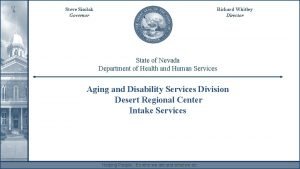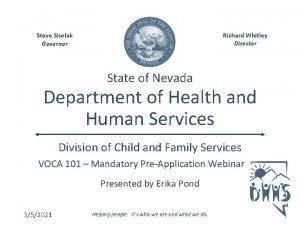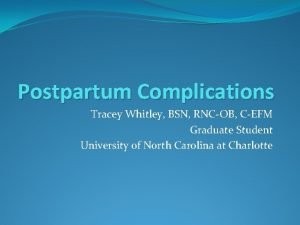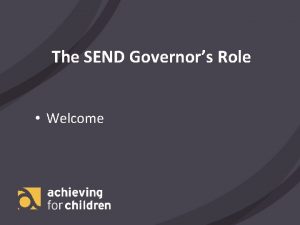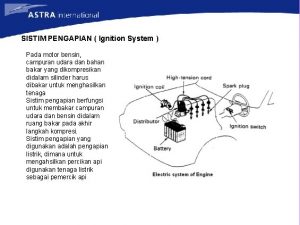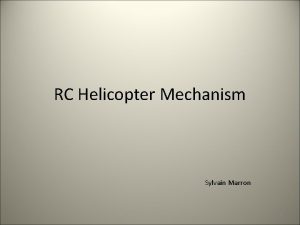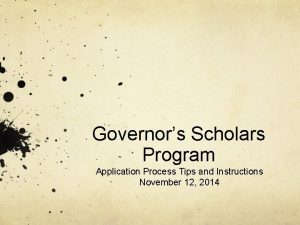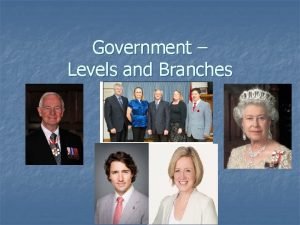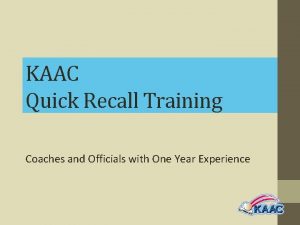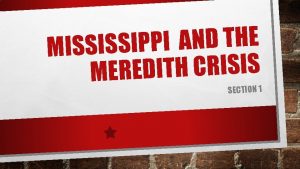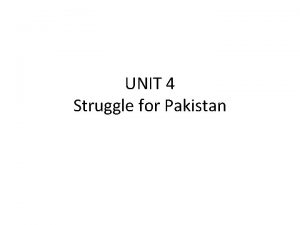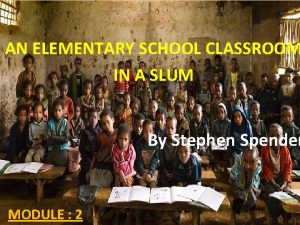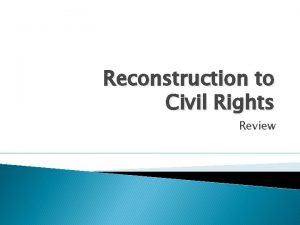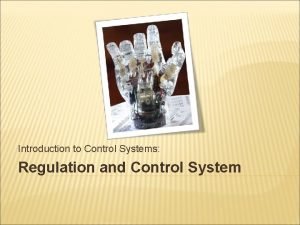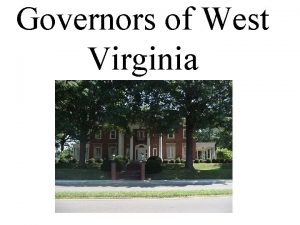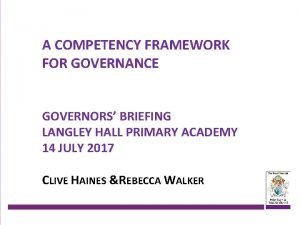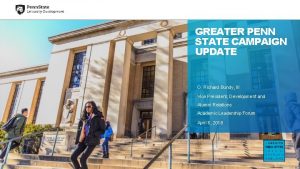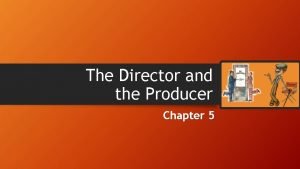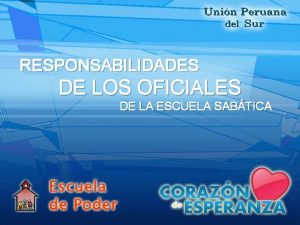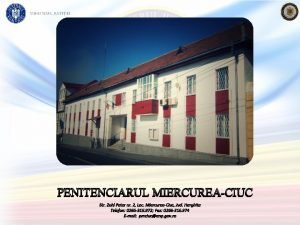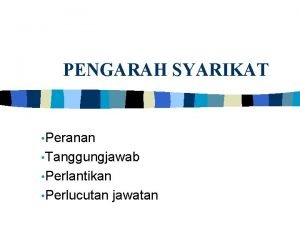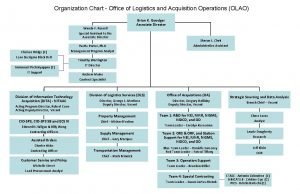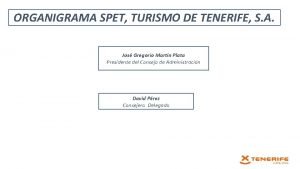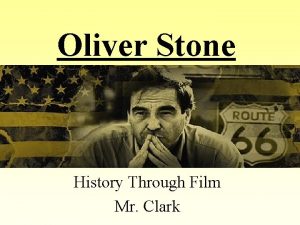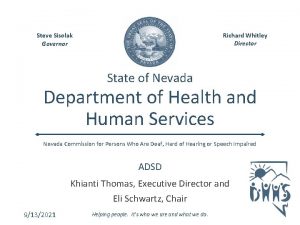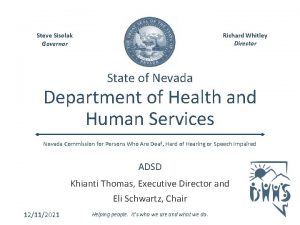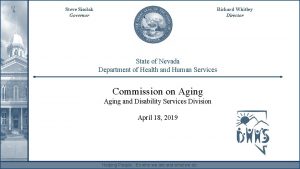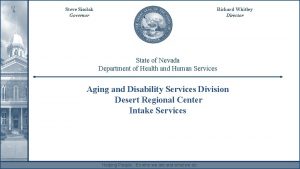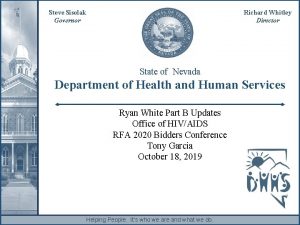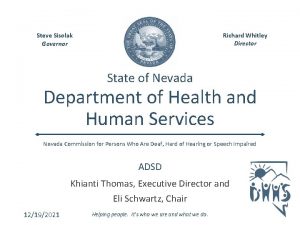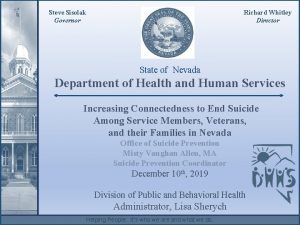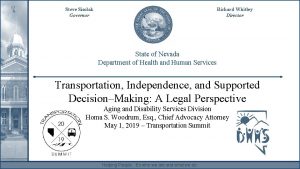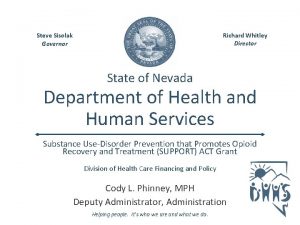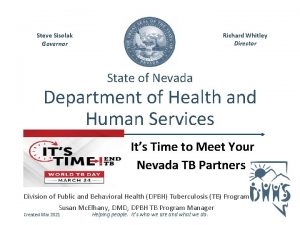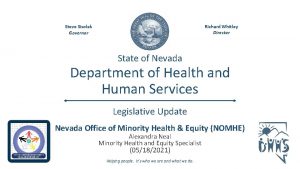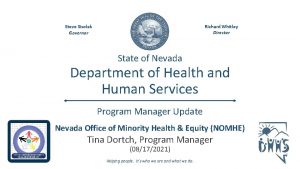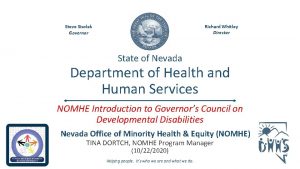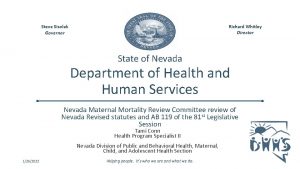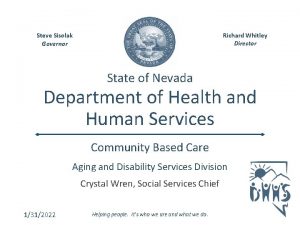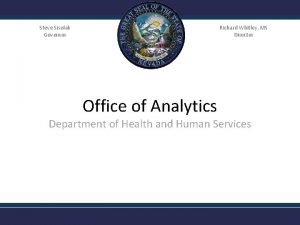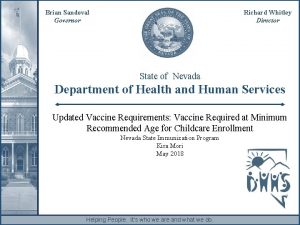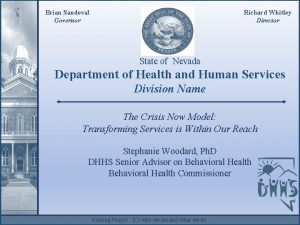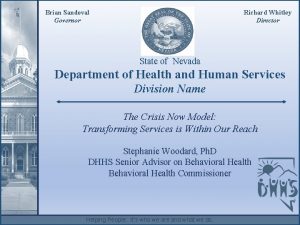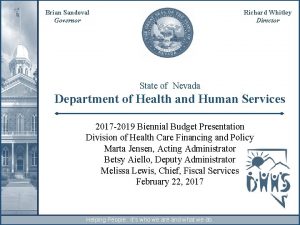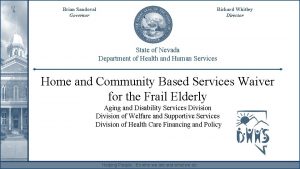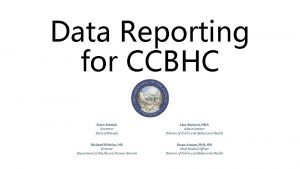Richard Whitley Director Steve Sisolak Governor State of









































- Slides: 41

Richard Whitley Director Steve Sisolak Governor State of Nevada Department of Health and Human Services Division of Child and Family Services VOCA 101 – Mandatory Pre-Application Webinar Presented by Erika Pond 3/5/2021 Helping people. It’s who we are and what we do.

Agenda 1. What is VOCA, Purpose, Usage of funds 2. Eligibility Requirements for Subrecipients 3. Victims Served 4. Cultural Competency 5. Allowable/Unallowable Costs 6. Application Materials 7. Scope of Work 8. Requests for Funds, Required Documentation 9. Match Requirement 10. Compliance- Performance Reporting, Subrecipient Monitoring 11. Timeline, Path to Success 2

What is VOCA • The Victims of Crime Act (VOCA) was passed by Congress in 1984 • Establishing the Crime Victims Fund generated from fines and penalties paid by convicted federal offenders, not tax dollars • Crime Victims Fund is distributed by Office of Victims of Crime (OVC) through the Department of Justice (DOJ) • The VOCA Assistance Program funding is available for states to fund and facilitate development of programs in every community to provide direct services to victims of crime. 3

VOCA in Nevada • Purpose: to promote and support quality victim assistance services programs throughout Nevada • Role of DCFS: • The Division of Child and Family Services (DCFS) is the State Administering Agency (SAA) that administers funding to subrecipients in Nevada. • The SAA is responsible for ensuring subrecipients meet eligibility and organizational requirements, Federal and State quality and compliance standards, tracking and reporting standards, and funding rules and regulations. 4

Usage of VOCA funds • Available to subrecipients to provide direct services. • Subrecipients must provide services to victims of federal crimes on the same basis as to victims of crimes under state or local law. 5

Eligible Subrecipients • Agencies providing direct services to crime victims • Comply with DCFS/VOCA grant requirements • Comply with Federal rules regulating VOCA assistance grants • Maintain statutorily required civil rights statistics on victims served by complying with civil rights requirements contained in various federal laws • Maintain confidentiality of client-counselor information, as required by state and federal law ensuring the confidentiality of information provided by crime victims to counselors working for victim services programs receiving VOCA funds • Help victims apply for Victims of Crime compensation program (VOCP) benefits • Have policies and procedures to safeguard the confidentiality of all victim personally identifiable information (PII) • Do not charge victims for VOCA-funded services • • Promote community efforts to aid crime victims Promote victim safety Have an active DUNS number Have completed Central Contractor Registration (CCR) 6

Eligible Subrecipients • Must meet program match requirements • Maintain records that clearly show the source, the amount, and the period during which the match was allocated • Operated by a public or private non-profit organization, or a combination of such organizations, and provide services to all types of crime victims • Have a record of effective services for victims of crime in their community • Provide meaningful access of services to Limited-English. Proficient (LEP) Persons - www. lep. gov • Provide services to victims of federal crimes on the same basis as victims of state and/or local crimes • Utilize volunteers in providing services to victims of all crimes • At least 25% of the program’s funding in the year of, or the year preceding the award comes from such sources, which may include other Federal funding programs. 7

Victims Served- VOCA Priority Areas • Funding priority is given to programs serving victims of: • • Sexual Assault Domestic Violence Child Abuse Underserved victims, include but are not limited to: Victims of elder abuse Victims of child abuse LGBTQIA victims Male victims Victims of violent crime in high crime urban areas Survivors of homicide, assault, robbery, economic exploitation, fraud • Victims of DUI crashes • Adults molested as children • Victims of hate/bias crimes • • • 8

Cultural Competency • The process of communicating with audiences from diverse geographic, ethnic, racial, cultural, economic, social, and linguistic backgrounds. • Importance: • Understanding and addressing cultural barriers such as stereotyping, value differences, communication styles, and language and interpreter bias, prepares victim advocates to provide effective service delivery within diverse communities and to recognize and value the diversity of their clients who are victims of crime. 9

Individual Cultural Competency • Individual views can be ethnocentric, biased and prejudiced • Ethnocentrism promotes a home culture’s ways of behaving and accomplishing tasks • Have a cultural willingness to engage, participate, and learn about cultural diversity and to raise your cultural awareness, knowledge and skills • Recognize that organizational culture may have its own defined sets of values, and demonstrate behaviors, attitudes, policies and structures that enable them to work effectively cross-culturally 10

Organizational Cultural Competence • To enhance cultural competence at the organizational level, organizations create policies and practices that: • Embrace diversity • Include multicultural practices • Identify a corresponding action plan that may include cultural competence training for administrators and staff; recruitment, mentoring, promotion, and retention of diverse staff; the use of interpreters, translation services and community health workers; familiarity with culture specific healing practices and ability to coordinate with culture specific healers; and the inclusion of family members. 11

Cultural Considerations Importance • A person’s own cultural background contributes to the positive or negative interpretation of communication, treatment options, and environment. • Services created with the dominant culture in mind may not translate into quality or compassionate care for cultures outside the norm. Examples of cultural competence in care delivery standards include: • Continually striving to overcome cultural, language, and communications barriers • Providing an environment where clients from diverse cultural backgrounds feel comfortable discussing their cultural health beliefs and practices when negotiating treatment options • Encouraging clients to express their spiritual beliefs and cultural practices • Being familiar with and respectful of various traditional healing systems and beliefs and integrating these approaches into treatment plans when appropriate 12

Allowable Costs • § 94. 119 Allowable direct service costs. • Immediate emotional, psychological, and physical health and safety • Personal advocacy and emotional support • Mental health counseling and care • Peer-support • Facilitation of participation in criminal justice and other public proceedings arising from the crime • Legal assistance • Forensic medical evidence collection examinations • Forensic interviews • Transportation • Public awareness • Transitional housing • Relocation 13

Allowable Costs (continued) • § 94. 120 Allowable costs for activities supporting direct services. • Coordination of activities • Supervision of direct service providers • Multi-system, interagency, multidisciplinary response to crime victim needs • Contracts for professional services • Automated systems and technology • Volunteer trainings • Restorative justice 14

Allowable Costs (continued) • § 94. 121 Allowable sub-recipient administrative costs. • • • Personnel costs Skills training for staff Training-related travel Organizational Expenses Equipment and furniture Operating costs VOCA administrative time Leasing or purchasing vehicles Maintenance, repair, or replacement of essential items Project evaluation 15

Allowable Costs VOCA funds may be used include, but are not limited to, the following: 1. Coordination of activities. 2. Supervision of direct service providers. 3. Multi-system, interagency, multidisciplinary response to crime victim needs. 4. Contracts for professional services. 5. Automated systems and technology. 6. Volunteer trainings. 7. Restorative justice. See 28 CFR 94. 120. 16

Emergency Shelter • VOCA funds may be used to pay for hotel accommodations for victims while a shelter is out of service or unavailable • The rule sets forth a non-exhaustive list of examples of allowable direct service costs, including costs associated with the immediate emotional, psychological, and physical health and safety of victims, such as emergency shelter. This may include hotel expenses in these circumstances. • 28 CFR 94. 119(5) 17

Direct Services for personal advocacy and emotional support • Personal advocacy and emotional support services include, but are not limited to, the following: 1. Working with a victim to assess the impact of a crime. 2. Identification of a victim’s needs. 3. Case management. 4. Management of practical problems created by the victimization. 5. Identification of resources available to the victim. 6. Provision of information, referrals, advocacy, and follow -up contact for continued services, as needed. 7. Traditional, cultural, and/or alternative therapy/healing (e. g. , art therapy, yoga). 18

Restorative Justice • Restorative justice activities support opportunities for crime victims to meet with perpetrators, including, but not limited to, tribal community-led meetings and peace-keeping activities, if such meetings are requested or voluntarily agreed to by the victim. • Victims must always have the opportunity to withdraw from participation, and there must be a reasonably anticipated beneficial or therapeutic value to the crime victim. • Ultimately, the state administering agency (SAA) maintains the discretion to determine what restorative justice activities it wishes to fund and has the responsibility of monitoring and overseeing the program. • 28 CFR 94. 120(g) 19

Unallowable Costs • § 94. 122 Expressly unallowable subrecipient costs. • Lobbying • Research and studies • Active investigation and prosecution of criminal activities, except for the provision of victim assistance services (ie. emotional support, advocacy, legal services) • Fundraising • Capital expenses (property loss, real estate purchases, mortgage payments) • Compensation for victims of crime • Medical care • Salaries and expenses of management (salaries, benefits, fees, furniture, equipment, and other expenses of executive directors, board members, and other administrators) 20

Application Materials • Section A – Application Form • Includes Section D. Application Type - select either Traditional or Innovative VOCA funding • Section B – Narrative • 80 points for Traditional VOCA • 100 points for Innovative VOCA • Extra 20 point section for Innovative funding to explain unmet need • Includes Scope of Work • Section C – Budget • Section D – Agency Self-Assessment • Section E – Past Compliance • Section F – Funding Request 21

Scope of Work • Framework that outlines the work to be performed by the subrecipients receiving VOCA funding • Details clear expectations for the project • Ensures project focus • Increases project success • Key elements: • Clarity (clear/easily understandable) • Precision (accurate representation of project) • Completeness (contains all required elements) 22

Scope of Work 1. Goal/Purpose - the ultimate result of the project Example – Provide therapeutic services for victims of crime in Nevada at no cost 2. Objective - what the project is trying to achieve Example – Serve 100 victims of crime, improve outreach to underserved victims of crime 3. Output - define the quantity or quality of effort put forth for the project; what the project delivers, activities Example - Provided trauma informed counseling to 100 youth or conducted 10 community education sessions 4. Outcome measures - determines the effect of the service - what has changed in the life of the client, community, family as a result of the service delivery and outputs of the organization. Example - 80% of families served reported decreased stress as measured by pre and post surveys, or 75% of teens demonstrated lower 23 risk of suicide as measured by clinical assessment

Scope of Work Components • Purpose • Project Objectives and Deliverables • Goals • Timeline • Special Requirements • Administration • Financial Estimates • Assumptions • Monitoring/Reporting 24

Scope of Work • SMART goals and objectives: • Specific- What exactly will you do/provide/implement? • Measurable- How will you measure what you have done and what the results of the work are? • Attainable- SMART objectives are achievable. • Realistic- Goals and objectives are realistic. • Timely- Goals and objectives can be completed within the lifetime of the grant. • Be concise and precise using simple and to-the-point language that is easy to understand increases project clarity. 25

Award Notification, Reimbursement • Notice of Sub-Award • Request for Funds • • • Personnel costs Fringe calculation Allocation methodology Indirect costs Match • Compliance • Performance Reporting • Subrecipient Monitoring • Deliverables 26

Requests for Funds • All costs charged to VOCA awards must be reasonable, allowable, and allocable. The DOJ Grants Financial Guide defines ‘reasonable’ as “those costs that a prudent person would have incurred under the circumstances prevailing at the time the decision to incur the cost was made. ” • RFR Coversheet • Excel Workbook • Backup Documentation • Personnel (Activity-based timesheets (detailing number of hours worked on VOCA and other grants), paystubs, payroll register for calculation of salary and fringe, cost allocation spreadsheet for other expenses or if employees work on multiple grants) • Travel (Mileage logs, invoices, flight itinerary, training description, receipts for registration fees, lodging, and other expenses) • DCFS is looking for the 5 C’s • Completeness, Correctness, Correlation, Consistency, Comprehensiveness 27

Calculation of Fringe • Fringe benefits must be allocated equitably to Federal and non-Federal funding sources and consistently across time periods based on the organization’s account basis • Fringe calculations billed to VOCA are based on the activity-based timesheets of the employees working under the VOCA grant • An explanation of the costs that contribute to the calculation of fringe must be submitted to DCFS to ensure accurate calculation of fringe • Backup documentation must be submitted to DCFS to provide proof of payment 28

Indirect Costs • Indirect costs are facility and administrative expenses that an organization incurs by undertaking a grant project • Indirect costs are not easily allocated to specific project costs and are NOT included as a direct cost in the grant budget. • Indirect costs are not budgeted as specific cost items, but rather are bundled into the rate that is charged against certain direct costs under the grant. • Specific costs included in an organization’s indirect cost rate vary, but typically include things like utility costs, organizational accounting fees, and equipment depreciation. • Indirect costs may be charged to an award only if (a) the recipient has a current (unexpired), approved negotiated indirect cost rate; or (b) the recipient is eligible to use, and elects to use, the de minimis 10% indirect cost rate 29

Allocation Methodology • Allocation of grant funding for employees who are paid from multiple grants • Cost allocation spreadsheet, shows the percentage the employee was budgeted to work on the grant • Activity-based timesheet shows what the number of hours are that the employee worked on VOCA to determine payroll and fringe reimbursement amounts • Subrecipients MUST retain documentation supporting the costs charged to grants • When separate awards cover substantially similar services, challenges arise. • For example, a full-time employee doing direct victim advocacy, is permitted under both VOCA and VAWA awards, so so challenges do arise in determining which hours get billed to which awards. • Documentation must support a reasonable allocation or distribution of costs among the programs 30

Reimbursement Policies • SAAs have the discretion to determine their internal reimbursement procedures, including the scope of source documents which must be reviewed prior to issuing a reimbursement. • OVC encourages SAAs to implement policies and procedures which balance the administrative burden on subrecipients and their need for predictable cash flows. • SAAs have a duty to protect grant funds from waste, fraud, and abuse. 31

Match Requirement • Match must be derived from non-Federal sources • Match is restricted to the same uses, and the same timing deadlines for obligation and expenditure, as the project’s VOCA funding. • Each subrecipient must maintain records that clearly show: • Source(s) and amount(s) of the contributions used as match • Time period that contributions were allocated • Basis for determining the value of personal services, materials, equipment, and space and facilities must be documented. • Volunteer services must be documented by the same methods used by the subrecipient for paid employees (ie. timesheets substantiating time worked on the project. ) 32

Match - Each Grant Cycle • Subrecipients may use the same source of match in different award cycles • In-kind contributions, including third party in-kind contributions, may be used • The transaction to provide the match must be documented • The valuation of in-kind contributions must be reasonable • Donated equipment, such as a computer, is limited to the fiscal year of the donation 33

Sources of Match • Cash (i. e. , the value of direct funding for the project). • Volunteered professional or personal services, the value placed is consistent with the rate of compensation (which may include fringe benefits) paid for similar work in the program; however, if the similar work is not performed in the program, the rate of compensation shall be consistent with the rate found in the labor market in which the program competes. • Materials/equipment, but the value placed on lent or donated equipment shall not exceed its fair market value. • Space and facilities, the value placed on which shall not exceed the fair rental value of comparable space and facilities as established by an independent appraisal of comparable space and facilities in a privately owned building in the same locality. • Non-VOCA-funded victim assistance activities, including, but not limited to, performing direct services, coordinating or supervising those services, training victim assistance providers, and advocating for victims 34

Match – Vehicles • Vehicles can be used as match • Subgrantees can only use either the vehicle’s fair market value or the actual expenses (e. g. , gas, insurance, maintenance) as match; they may not charge both as match. • The only portion of the cost that can be used as match is the portion associated with transporting victims. • Subgrantees need to provide supporting documentation of the in-kind match. 35

Compliance Monthly Financial Status and Request for Funds Report Due on the 15 th of each month even if no reimbursement is required Performance Reports – Quarterly reports are due by the 15 th of the month following the end of the reporting quarter On-Site Monitoring - DCFS conducts biennial on-site monitoring to provide ongoing technical support to subrecipients Compliance with Changes to Federal and State Laws • Subrecipients are required to respond to and adhere to any and all new regulations and requirements • Adherence to Federal Civil Rights obligations Nevada 2 -1 -1 • Subrecipients are required to add or update agency’s profile on Nevada’s 2 -1 -1 website www. nevada 211. org 36 within 60 days after receiving notification of award

Keys to Success • Communication – Ask DCFS your questions, we will provide timely and courteous responses • Technical Assistance – DCFS will provide additional training and assistance to ensure your success • Teamwork – Let’s work together to ensure quality deliverables, adherence to deadlines, grant compliance and commitment to growth and sustainability 37

Timeline • • • VOCA Application Submittal – by February 7, 2020 by 5 pm PST Application Review – February 2020 Funding decisions – Early March 2020 Notice of Sub-Award (NOSA) – notification of performance period and funding amount Request for Funds – VOCA funds paid on a reimbursement basis Monthly Financial Status Reports – due by 15 th of the month Performance Reports – due by 15 th of the month following end of reporting quarter Subrecipient Monitoring Nevada 2 -1 -1 38

Questions? 39

Contact Information Erika Pond Jean Booth Victim Services Supervisor Grants & Projects Analyst Erika. Pond@dcfs. nv. gov Jean. Booth@dcfs. nv. gov 775 -684 -5934 775 -684 -4447 http: //dcfs. nv. gov/Programs/GMU/ Email: DCFSgrants@dcfs. nv. gov 40

• • • • • Acronyms CCR – Central Contact Registration CFR – Code of Federal Regulations DCFS – Division of Child and Family Services DUI – Driving Under the Influence DOJ – Department of Justice DUNS – Data Universal Number System LEP – Limited English-Proficient Persons LGBTQIA - Lesbian, Gay, Bisexual, Transgender, Queer/Questioning, Intersex, and Asexual or Allied NOFO – Notice of Funding Opportunity NOSA – Notice of Sub-Award OVC – Office of Victims of Crime PII – Personally Identifying Information SAA – State Administering Agency SMART – Smart, Measurable, Attainable, Realistic, Timely SOW – Scope of Work VAWA – Violence Against Women Act VOCA – Victims of Crime Act Assistance Program VOCP – Victims of Crime Compensation Program 41
 Richard whitley nevada
Richard whitley nevada Richard whitley nevada
Richard whitley nevada Ronald wayne biography
Ronald wayne biography Whitley bay ice rink coaches
Whitley bay ice rink coaches Nursing management of pph
Nursing management of pph Geelong district football league
Geelong district football league Looking for richard
Looking for richard Role of send governor
Role of send governor Fungsi dari centrifugal governor advancer adalah
Fungsi dari centrifugal governor advancer adalah Rc helicopter governor
Rc helicopter governor Governor in engine
Governor in engine 2sencos
2sencos Governor watt adalah
Governor watt adalah Paraphrase each of the following sentences in two ways
Paraphrase each of the following sentences in two ways Ms governor's school
Ms governor's school Governor's scholars program application
Governor's scholars program application What level of government is the governor
What level of government is the governor The reform discussed by governor johnson in this excerpt -
The reform discussed by governor johnson in this excerpt - Nc governor's school 2021
Nc governor's school 2021 Kaac conference
Kaac conference Harry s murphy ole miss
Harry s murphy ole miss Central governor
Central governor In which city urdu hindi controversy started
In which city urdu hindi controversy started Kentucky governor's office of early childhood
Kentucky governor's office of early childhood On sour cream walls donations shakespeare's head
On sour cream walls donations shakespeare's head Literary devices in an elementary school
Literary devices in an elementary school What did lester maddox accomplish as governor *
What did lester maddox accomplish as governor * Watt's flyball governor block diagram
Watt's flyball governor block diagram First governor of wv
First governor of wv Development hub sheffield
Development hub sheffield Direct characterization in the crucible act 1
Direct characterization in the crucible act 1 Governor induction pack
Governor induction pack Competency framework for governance
Competency framework for governance O. richard bundy iii
O. richard bundy iii The text-based director, also known as the
The text-based director, also known as the Deberes de un director de escuela
Deberes de un director de escuela Program vizita penitenciar miercurea ciuc
Program vizita penitenciar miercurea ciuc Peranan pengarah syarikat
Peranan pengarah syarikat Logistics organization chart
Logistics organization chart Director marketing turistico tenerife
Director marketing turistico tenerife Oliver stone
Oliver stone Salaam bombay director
Salaam bombay director
